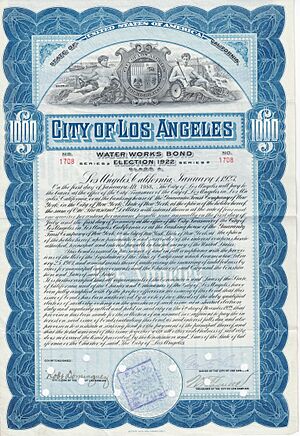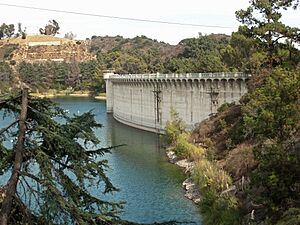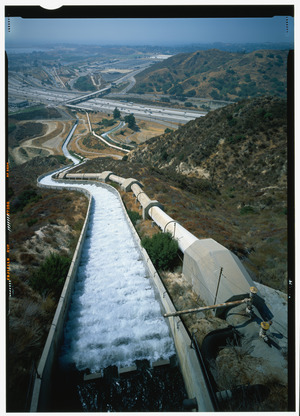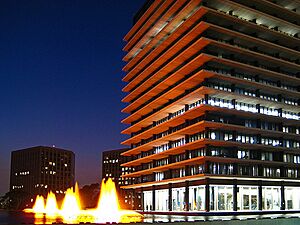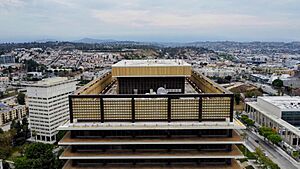Los Angeles Department of Water and Power facts for kids
 |
|
| Agency overview | |
|---|---|
| Formed | 1902 (water) 1916 (electric) |
| Preceding agency |
|
| Type | Water infrastructure and electricity |
| Headquarters | John Ferraro Building 111 North Hope Street Los Angeles, California 34°03′29″N 118°14′58″W / 34.0580°N 118.2495°W |
| Employees | 11,000 employees |
| Annual budget | US$6.1 billion (fy2017/2018) |
| Agency executive |
|
| Website | www.ladwp.com |
The Los Angeles Department of Water and Power (LADWP) is the biggest public utility in the United States. It provides electricity and water to over four million people and businesses in Los Angeles and nearby areas.
LADWP started in 1902 to bring water to homes and businesses. In 1917, it also began providing electricity. Over the years, LADWP has been part of important events, like the 1928 St. Francis Dam collapse.
Contents
History of Water and Power in Los Angeles
Early Water Systems
In the mid-1800s, Los Angeles was growing fast. The city's water system, which used open ditches, was not good enough for homes. In 1853, city leaders said no to a new system with pipes because it cost too much.
Later, in 1857, the city tried to get private companies to build a better water system. One company, led by William G. Dryden, built a system with wooden pipes. But heavy rains in 1861 destroyed it. Other attempts by private companies also failed.
In 1868, the city gave up its rights to the water from the Los Angeles River. A new company, the Los Angeles City Water Company, was formed. This company took much more water than it was allowed. As their contract ended in the 1890s, people wanted the city to take back control of the water supply.
City Takes Control of Water
Fred Eaton, who had worked for the water company, suggested that Los Angeles could provide water to its residents without charging them directly, using tax money. In 1897, the city decided not to renew the Los Angeles City Water Company's contract.
In 1898, the city began talks to buy the water system from the company. They wanted the company's experienced workers to stay. William Mulholland, who was in charge of the water system, was asked for records and maps. He said he had memorized all the important details, like pipe sizes and valve locations, because no records existed. He proved he knew everything and got a job with the city. He then helped the company's main owner agree to sell the system to the city for two million dollars.
Bringing Electricity to the City
The Los Angeles Bureau of Power and Light was created in 1911 to manage the city's electricity. At first, it bought power from private companies. In 1922, it bought Southern California Edison's power system within Los Angeles.
By 1937, the Bureau bought another large power company, Los Angeles Gas and Electric Corporation. This made it the main power provider in the city. That same year, the Bureau of Power and Light joined with the Bureau of Water Works and Supply to become the Los Angeles Department of Water and Power (LADWP). By 1939, LADWP was the only electricity provider for Los Angeles.
LADWP first offered city electricity in 1917. This power came from Power Plant No. 1, a hydroelectric power plant in San Francisquito Canyon. It used water from the Los Angeles Aqueduct to make electricity. This plant still works today, providing power for many homes.
Power Plant No. 2 was added in 1920. It was destroyed when the St. Francis Dam failed, but it was rebuilt quickly and still operates.
On January 17, 1994, Los Angeles had a total power outage because of the 1994 Northridge earthquake. Most power was back on within a few hours. In September 2005, a worker accidentally cut power lines, causing half of Los Angeles to lose power for about 90 minutes.
Important Events and Challenges
On March 12, 1928, the St. Francis Dam, which LADWP built and ran, broke apart. This disaster caused a huge flood, leading to the second-greatest loss of life in California's history after the 1906 San Francisco earthquake. About 425 people died. Confusion among workers meant warnings were not sent quickly enough to towns downstream. William Mulholland took full responsibility and retired the next year.
LADWP has also been a key player in the struggle over water from the Owens Valley. This includes getting water rights and managing Mono Lake and Owens Lake.
LADWP helped build the Hoover Dam and bring its energy to Los Angeles. LADWP operated the Hoover Dam electrical facility with Southern California Edison until 1987.
In October 2011, LADWP helped start the LA Cleantech Incubator. This group helps new companies that focus on clean technology.
In October 2022, LADWP lost a lawsuit about dust control on Owens Lake. The Great Basin Unified Air Pollution Control District sued them for not controlling dust near important tribal land.
Concerns About Payroll Costs
LADWP has faced criticism regarding its payroll costs. In 2018, the agency spent a large amount on overtime pay. An independent study found that LADWP's payroll expenses per customer were higher than many other large utility companies across the country.
How LADWP Provides Power
In 2019–2020, LADWP supplied over 21,130 gigawatt hours of electricity to more than 1.5 million customers.
LADWP uses different ways to make electricity:
- 24% comes from natural gas power plants.
- 21% comes from coal-fired plants in Utah and Arizona, but LADWP plans to stop using coal by 2025.
- 14% comes from nuclear power, from the Palo Verde Nuclear Generating Station in Arizona.
- About 2% comes from hydropower, mostly from Hoover Dam and the Los Angeles Aqueduct system.
LADWP also operates the Castaic Power Plant. This plant stores water and releases it to make power when electricity demand is high. Then, at night, it pumps the water back up when there is extra power available. This plant generates about 22% of LADWP's total power.
LADWP has a large system that spans five Western states. It brings electricity to over 4 million people in Los Angeles.
Moving Towards Cleaner Energy
In 2004, the Los Angeles City Council asked LADWP to get 20% of its energy from clean sources by 2010. LADWP met and even went beyond this goal. They also met goals of 25% renewables by 2016 and 33% by 2020.
As of 2020, about 37% of LADWP's power comes from "green power" or renewable energy sources. This includes the 120 MW Pine Tree Wind Farm, which is the largest wind farm owned by a city in the United States. LADWP is also investing in solar power and geothermal energy.
In March 2021, LADWP announced the results of the Los Angeles 100% Renewable Energy Study ("LA100"). This study showed how LADWP could get all its energy from renewable sources as early as 2035, and by 2045 at the latest. This plan includes a lot more wind and solar power.
As of 2020, renewable energy was the largest part of LADWP's power supply at about 37%. Natural gas was next at about 24%, and coal-fired power made up 21%. LADWP plans to be coal-free by 2025.
Underground Power Lines
Most power lines in Los Angeles were built above ground. Since 2007, LADWP has been working on a long-term project to move these power lines underground. This is a difficult and costly project. It is also slow because of budget limits, traffic problems, and other modernization projects.
Underground power lines cost much more than overhead lines. Also, it's currently very hard to put the largest transmission lines underground. LADWP is also upgrading its overhead lines by replacing old parts with newer, more modern ones.
The department recently finished two large underground projects using a new cable technology that doesn't use oil. This is better for the environment.
How LADWP Provides Water
In 2019, LADWP provided about 159 billion gallons of water to over 735,000 connections through 7,340 miles (11,810 km) of pipes. From 2016 to 2020, the water came from these sources:
- 48% from the Sierra Nevada mountains through the Los Angeles Aqueduct. This water flows by gravity, so it doesn't need electricity to move.
- 41% from the Metropolitan Water District of Southern California. This water comes from the California Aqueduct and Colorado River Aqueduct. Moving this water uses a lot of electricity.
- 9% from local groundwater. This water source is carefully managed but can be affected by pollution.
- 2% from recycled water, used for watering plants, recreation, and industry.
The amount of water from each source can change a lot each year.
Because Los Angeles needs more water and some sources might provide less, LADWP is looking for new ways to get water. This includes connecting directly to the California Aqueduct, using more recycled water, collecting and reusing stormwater, and encouraging people to save water. Many old pipelines are wearing out, so LADWP is replacing them on major streets.
Areas LADWP Serves
Besides Los Angeles, LADWP also provides services to parts of:
Overall, LADWP serves four million people and businesses in its service area.
How LADWP is Managed
Board of Water and Power Commissioners
LADWP is overseen by a group of five people called the Los Angeles Board of Water and Power Commissioners. The Mayor of Los Angeles chooses these members, and the Los Angeles City Council approves them. They serve for five years.
The Board decides on important things like water and electricity rates, new clean energy projects, and employee benefits. They usually meet twice a month. Their meeting plans are available to the public before each meeting.
In May 2023, Cynthia Ruiz, the first Native American on the Board, was removed from her position by Mayor Karen Bass. George McGraw took her place in June.
Executive Leadership
The daily operations of LADWP are managed by the general manager, along with other senior leaders, the chief financial officer, and legal advisors.
In January 2014, Ron Nichols resigned as chief of LADWP.
On February 21, 2014, Marcie L. Edwards became the first woman to lead LADWP. She was approved by the Los Angeles City Council. Before this, Edwards was the City Manager of Anaheim and had led Anaheim Public Utilities for 13 years. She started working at LADWP as a clerk typist when she was 19.
In August 2016, Marcie L. Edwards announced her retirement. David H. Wright became the Interim General Manager and later the permanent General Manager until 2019.
LADWP veteran Martin L. Adams was confirmed as General Manager on September 13, 2019.
In 2024, Janisse Quiñones was nominated by Mayor Karen Bass to be the new head of LADWP. The City Council approved her for this high-paying role.
LADWP Headquarters
LADWP's main office is in a 17-story building designed by A.C. Martin & Associates. It was finished in May 1965. The building was built to bring together 11 different offices and house LADWP's 3,200 employees. On September 21, 2012, it was named a Los Angeles Historic-Cultural Monument.
The building was renamed the John Ferraro Building on November 16, 2000, after the late Los Angeles City Councilman John Ferraro. The building was also shown in the 2010 science fiction movie Inception.
See also
- Glendale Water and Power Department
- Intermountain Power Agency
- Metropolitan Water District of Southern California
- Hyperion sewage treatment plant
- Cristobal Aguilar, a Los Angeles mayor who in 1868 stopped a plan to sell Los Angeles's water rights


